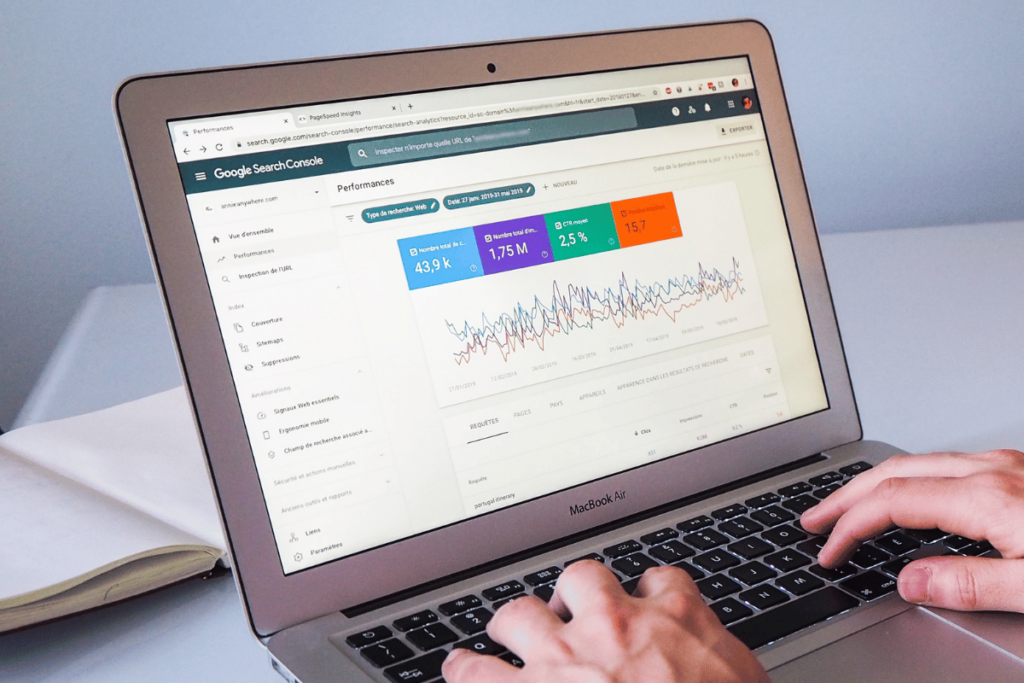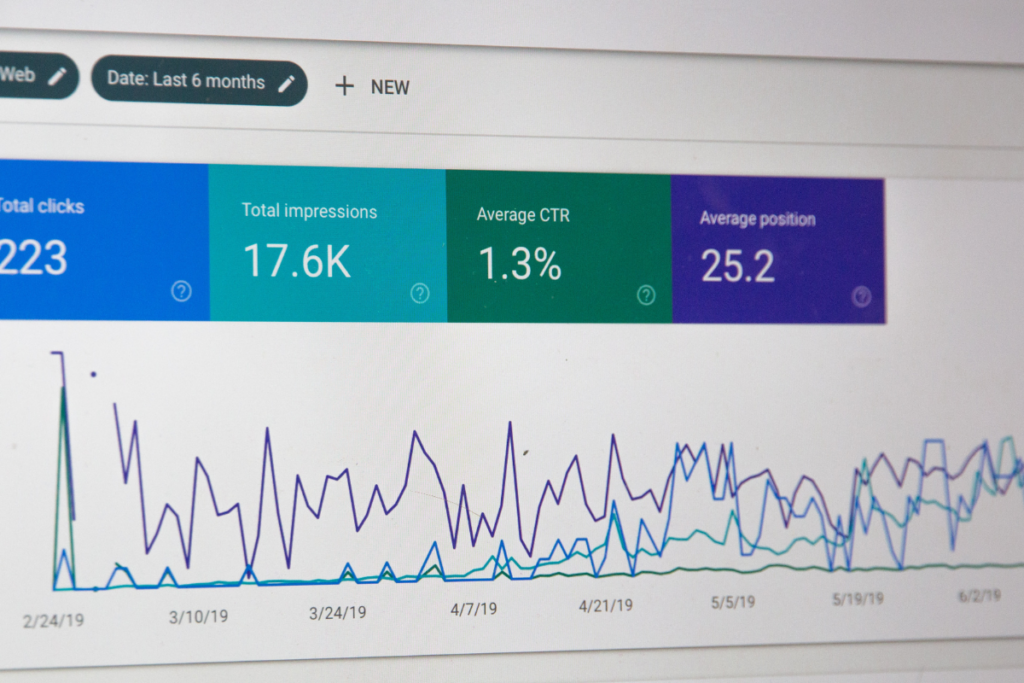One of the most sure-shot elements for the success of a strategy is to set standards for comparing your progress. In technical terms, that is called benchmarking. And in the world of SEO, it differentiates between a successful and ineffective SEO strategy.
This detailed guide will answer your questions and provide tips and tools to help you with SEO benchmarking. So let’s get started.

What is SEO Benchmarking?
SEO benchmarking means using standard and widely recognized metrics to evaluate your website’s value and effectiveness in your industry.
When building and executing your SEO strategy, you set key performance indicators (KPIs) as reference points.
For example, organic traffic is an OKR that measures how many users visit your website from unpaid search results. You can use last month’s organic traffic as a benchmark and compare it with the current month’s traffic to see if you have improved or declined.
SEO benchmarking is essential because it helps you:
- Understand your current SEO performance and how it compares to your competitors and industry averages.
- Identify the gaps and scope for improvement in your SEO strategy.
- Set SMART (Specific, Measurable, Achievable, Relevant, and Time-bound) goals and objectives for your SEO campaign.
- Monitor and measure your SEO results and ROI over time.
- Communicate the roadmap and impact of your SEO efforts to the stakeholders.
How Do You Set Effective SEO Benchmarks?
Follow these steps to set effective SEO benchmarks:
- Evaluate the current state of your website from an SEO standpoint. Analyze the current traffic, backlink profile, domain/page authority, bounce rate, and conversion rate.
- Set specific goals with realistic expectations. For example, if you are running a SaaS company, you can use organic conversion rates and UX as a benchmark. Similarly, you can use organic traffic, scroll depth, and backlink profiles as benchmarks if you have an affiliate website.
- Conduct a competitor analysis to understand the industry trends and benchmarks.
- Begin with your SEO efforts and rinse-repeat as you learn and adjust the strategy.

4 Benefits of SEO Benchmarking
SEO benchmarking can help you improve your SEO performance and achieve your SEO goals. Here are some of the benefits of SEO benchmarking:
1. Identify Strengths and Weaknesses
By measuring and comparing your SEO metrics with your competitors and industry averages, you can find the strengths and loopholes of your SEO strategy. You can also discover the gaps and opportunities to improve your SEO performance.
2. Conduct Competitor Analysis
By benchmarking your SEO performance against your competitors, you gain critical insights into their SEO strategies and tactics. You can learn from their best practices, avoid mistakes, and improve. You can also identify their unique selling points (USPs) and differentiators and find ways to outperform them.
Use tools like Ahrefs or SEMRush to analyze your competitors’ keywords, content, backlinks, SERP features, etc, and understand why they rank better.
3. Set Realistic Goals
By benchmarking your SEO performance against your industry averages, you can set realistic and achievable goals for your SEO campaign. You can also align your SEO goals with your business goals and objectives.
4. Track Progress and ROI
You can measure your progress and ROI by benchmarking your SEO performance, which can help you optimize your SEO methods and tactics based on relevant data. Tools like Google Analytics, Google Search Console, Bing Webmaster Tools, and Ahrefs will help monitor and analyze your SEO performance and ROI.

6 SEO Benchmark Metrics
SEO benchmark metrics are the key indicators that measure and compare your website’s performance for search engine optimization. Here are the six most important SEO benchmark metrics you should focus on and a quick overview of how to improve them.
1. Organic Search Traffic
Organic search traffic is the number of users who land on your website from unpaid search results through search engines. It is one of the most essential SEO benchmark metrics, as it reflects if your website is optimized for search engines (SERPs) and the relevance and value of your content for your target audience.
Here’s what you can do to improve your organic search traffic:
- Conduct detailed keyword research and optimize your website for relevant and high-intent keywords that match your target audience’s search intent and needs.
- Create high-quality, engaging, informative content that provides value to your target audience’s problems and questions. Following Google’s EEAT metrics when writing content is a good practice.
- Optimize the website’s technical SEO aspects, such as site speed, security, crawlability, indexability, and structured data.
- Build a strong and diverse backlink profile to signal authority and trustworthiness to search engines and users.
- Monitor and analyze your organic traffic performance and identify the gaps and opportunities for improvement.
2. User Experience (UX) Signals
User experience (UX) signals are the metrics that measure the success of users’ interaction with your website. They are also a critical SEO benchmark metric and significantly impact your website’s search engine rankings (SERPs). Key UX signals are load speed, mobile-friendliness, engagement, and website navigation.
To improve your UX signals, you can:
- Optimize your site’s pages for faster loading times.
- Make your website mobile-friendly, responsive, and adaptable to different devices and browsers.
- Increase your website engagement, retention times, and scroll depth. You can create compelling headlines, add visuals and multimedia, use clear and concise language, and add relevant calls to action (CTAs) for this.
- Improve your website navigation, usability, and accessibility.

3. Impressions & CTR
Impressions and click-through rates (CTR) measure the number of times your website appears in the search engine results pages (SERPs) and how many users click on your website from the SERPs. Their importance lies in indicating how visible and attractive your website is for your target keywords and audience.
To improve the impressions and CTR, you need to:
- Conduct keyword research and target relevant short and long-tail keywords that match your target audience’s search intent and needs.
- Optimize your website’s on-page aspects, such as title tags, meta descriptions, headings, images, and internal links.
- Leverage SERP features like featured snippets, rich results, local packs, and knowledge panels.
- Monitor and analyze your impressions and CTR performance and identify the gaps and opportunities.
4. Keyword Rankings In The Target Location
Keyword rankings in the target location are the positions of your website’s pages in the SERPs for specific keywords or queries in a specific geographic area. They are a vital SEO benchmark metric, especially for websites targeting a particular location.
What is Keyword Benchmarking?
Keyword benchmarking is measuring and comparing the performance and optimization of your target keywords and queries on search engines.
The benchmarking is usually divided into two parts, one targeting short-tail keywords and the other targeting long-tail keywords. It considers the keywords your site ranks for in the top 15-20 search results, the keywords driving the most and least traffic, and the keywords you should aim to rank for.
Benchmarking keywords can help you target the right keywords, increase your visibility and relevance on search engines, and attract more organic traffic and conversions.

5. Quality and Quantity of Linking Root Domains
Quality and quantity of linking root domains are the metrics that measure how many unique domains link to your website and their authority and relevance. Also known as backlink profile, this benchmark is essential and affects how search engines evaluate and rank your website.
The backlink profile indicates to search engines that your website has quality content that others use as a reference. It also shows that the linking domains are willing to redirect their visitors to your website for a better user experience.
While the quantity of linking domains is a significant factor, the quality of linking root domains outweighs it by far. For example, 10,000 links from low-authority sites are of little to no value against one high-quality link from a top authority website like the New York Times.
To improve your quality and quantity of linking root domains, you need to:
- Create high-quality, engaging, in-depth content that provides value to your target audience.
- Build a strong, diverse backlink profile that signals authority and trustworthiness to search engines and users.
- Optimize your website’s technical aspects, such as speed, mobile-friendliness, and UI/UX.
- Constantly monitor and analyze your quality and quantity of linking root domains.
6. Organic Conversions
Organic conversions are the metrics that measure how many users who visit your website from unpaid search results complete a desired action, such as signing up, subscribing, purchasing, or contacting. As an essential SEO benchmark metric, it reflects the efficiency of your website in converting organic traffic into leads, customers, or revenue.
For benchmarking, you track and analyze different aspects of your organic conversions, such as the number, conversion rate, value, traffic sources and channels, devices, locations, customer demographics, keywords, and queries that generate the most organic conversions.

Top 4 Best SEO Benchmarking Tools
Here are the top 4 SEO benchmarking tools you can use to measure and compare your website’s performance –
1. Ahrefs
Ahrefs is among the world’s most popular and powerful SEO benchmarking tools. It boasts a vast and updated database of over 240 billion crawled pages, 16 trillion known links, and 10 billion keywords. It offers a comprehensive and user-friendly array of tools to help you with various aspects of SEO benchmarking, such as:
-
Site Explorer: A sub-tool in the Ahrefs dashboard that allows you to analyze a website’s organic traffic, rankings, backlink profiles, and more.
- Keywords Explorer: It allows you to research your target keywords and queries.
- Site Audit: You can use it to get an overall glimpse and find and fix any technical issues affecting your SEO performance.
- Rank Tracker: It allows you to track your keyword rankings in the target location over time. You can also use it to monitor and measure your impressions, clicks, and CTR for each keyword and query.
- Content Explorer: This tool lets you discover your niche’s most popular and relevant content.
2. SEMrush
SEMrush is another popular and powerful SEO benchmarking tool. It has an updated database of over 20 billion keywords, 800 million domains, and 142 geodatabases. It offers a comprehensive and user-friendly suite of tools that can help you with various aspects of SEO benchmarking, such as:
- Domain Analytics: It allows you to analyze your website’s organic traffic, keyword rankings, backlink profile, and more.
- Keyword Analytics: This tool allows you to research and benchmark your target keywords and queries.
- Site Audit: It lets you audit and benchmark your website’s technical aspects and gives you an overall picture of what needs to be done for SEO.
- Position Tracking: You can monitor and measure your impressions, clicks, and CTR for each keyword and query.
- Content Marketing Platform: It allows you to create high-quality, engaging, and informative content that provides value and solutions to your target audience’s problems and questions.

3. Google Analytics
Google Analytics is among the most widely used and trusted SEO benchmarking tools worldwide.
The best part is that it is free and helps you accurately measure and analyze your website’s traffic, behavior, and conversion performance for Google SERPs.
It offers a comprehensive and user-friendly suite of tools that can help you with various aspects of SEO benchmarking, such as:
- Audience: You can analyze and benchmark your website’s audience, such as the channels, characteristics, and behavior of your website’s visitors.
- Acquisition: You can also use it to measure and compare the performance and ROI of your different traffic sources and channels, such as organic, paid, social, email, and referral.
- Behavior: It lets you analyze your website’s user behavior, such as the actions, interactions, and engagement of your website visitors.
- Conversions: Use it to measure and compare the performance and ROI of your different conversion goals and funnels, such as sign-ups, subscriptions, purchases, or contacts.
4. Google Search Console
Google Search Console is another widely used and trusted SEO benchmarking tool.
Just like Google Analytics, Google Search Console is also a free tool that lets you monitor and optimize your website’s performance and visibility in Google Search.
It offers a comprehensive and user-friendly suite of tools that can help you with various aspects of SEO benchmarking, such as:
- Performance: You can analyze and benchmark your website’s performance in Google search, such as the number, position, and trend of your impressions, clicks, and CTR.
- Coverage: Analyze your website’s coverage in Google search, such as the number, status, and issues of your indexed and non-indexed pages.
- Enhancements: Through this tool, you can analyze your website’s improvements in Google search, such as the number, status, and issues of your rich results, mobile usability, and structured data.
- Links: You can explore your website’s links in Google search, such as the number, quality, and relevance of your external and internal links. It also helps measure and compare the link’s profile in Google.

Website Benchmarks By Industry
Let’s look at the average values of website benchmarks across some of the most popular industries online.
Average Website Traffic By Industry
Website traffic represents the number of visits, users, and pageviews a website receives. It indicates a website’s popularity and engaging design and how well it ranks on search engines. According to a report by Databox, these are the median values of monthly website traffic by industry:
- E-commerce: 9.57K sessions, 7.38K users, 21.5K pageviews
- SaaS: 3.16K sessions, 2.44K users, 6.64K pageviews
- Education: 6.54K sessions, 5.03K users, 15.8K pageviews
- Health: 4.25K sessions, 3.28K users, 9.76K pageviews
The overall median values across all industries were 3.93K sessions, 3.02K users, and 9.29K pageviews. As you can see, e-commerce and Education had higher than average website traffic, while SaaS and Health had lower than average website traffic.
Average Click-through Rate (CTR) By Industry
Click-through rate (CTR) is a metric to represent the percentage of users who clicked on a CTA (link or an ad) after seeing it. It measures how relevant and attractive a link or an ad is to the target audience. According to a report by First Page Sage, based on data from 2019 to 2023, these are the average CTRs by industry for Google ads and organic search results:
- E-commerce: 1.7% for Google ads, 35.4% for organic position 1, 15.2% for organic position 2, and 8.8% for organic position 3
- SaaS: 2.1% for Google ads, 39.8% for organic position 1, 19% for organic position 2, and 11.3% for organic position 3
- Education: 0.9% for Google ads, 37.5% for organic position 1, 18.8% for organic position 2, and 10% for organic position 3
- Health: 1.4% for Google ads, 41.2% for organic position 1, 19.1% for organic position 2, and 11.1% for organic position 3
The overall average SEO CTR benchmark across these industries was 1.6% for Google ads, 39.6% for organic position 1, 18.4% for organic position 2, and 10.1% for organic position 3. SaaS and Health had higher-than-average CTRs, while e-commerce and Education had lower-than-average CTRs.

Average Bounce Rate By Industry
Bounce rate measures the percentage of users who abandon a website after engaging with only one page. It indicates how engaging and relevant a website is to the visitors.
A high bounce rate may suggest that the website needs to meet the expectations or needs of the users or that the website has technical or usability issues.
According to a report by Hubspot, based on data from 2023, these are the average bounce rates by industry:
- E-commerce: 47%
- SaaS: 58%
- Education: 58%
- Health: 59%
The overall average bounce rate across these industries was 55%. E-commerce had a lower-than-average bounce rate, while SaaS, Education, and Health had higher-than-average bounce rates. If you’re wondering what is a good bounce rate, then the general rule of thumb suggests to keep it below 40%
Average Conversion Rate By Industry
Conversion rate is a metric that evaluates the percentage of users who complete a specific action on a website, such as a purchase, newsletter sign-up, or filling out a form. It is a measure of how effective a website is at converting visitors into potential customers or leads.
According to a report by Ruler Analytics, based on data from 2019 to 2023, these are the average conversion rates by industry:
- E-commerce: 2.2%
- SaaS: 3.9%
- Education: 2.9%
- Health: 3.1%
The overall average conversion rate across these industries was 3.9%. The data asserts that SaaS had a higher-than-average conversion rate, while e-commerce had a lower-than-average conversion rate.
Frequently Asked Questions (FAQs)
Here’s a quick FAQ section to answer your questions about SEO benchmarking.
How Often Should SEO Benchmarks Be Reviewed and Updated?
It depends on your industry, competition, goals, and resources. However, a general rule of thumb is to review and update your SEO benchmarks at least once every quarter. It will help you keep track of your progress, identify any changes or issues, and adjust your strategy accordingly.
Is SEO Benchmarking Relevant for All Types of Websites?
SEO benchmarking is relevant and beneficial for all types of websites, regardless of their size, niche, or purpose. Whether you have an e-commerce site, a SaaS site, or a personal blog, SEO benchmarking can help you improve your website’s performance and visibility on search engines, attract organic traffic, and achieve your business goals.
Can SEO Benchmarking Help in Identifying Areas for Improvement?
Yes, SEO benchmarking can help you identify the areas for improvement in your SEO strategy and tactics. By measuring and comparing your SEO performance with your competitors and industry averages, you can discover the gaps and opportunities for improvement in your SEO performance.
How Does User Experience Impact SEO Benchmarking?
User experience (UX) is users’ overall impression and satisfaction when interacting with your website. It is a crucial factor that impacts your SEO benchmarking, affecting how search engines and users perceive and evaluate your website. A good UX can improve your SEO performance and benchmarks, while a bad UX can harm it.
Conclusion
SEO benchmarking is a powerful and essential practice for a successful SEO campaign. You can use the right tools and metrics to compare your SEO performance with your competitors and industry averages. Benchmarking gives you an organized display of your current SEO health and helps identify your strengths and weaknesses, set realistic goals, and track progress.
At TrioSEO, we help you set realistic expectations and achieve the most optimum SEO results relevant to your business. Book a consultation call with us to learn how we can improve your SEO benchmarking metrics.




![Featured Image - Mental Health Content Writing [Best Practices and Ethical Considerations]](https://trioseo.com/wp-content/uploads/2024/05/Mental-Health-Content-Writing-Best-Practices-and-Ethical-Considerations-300x157.png)
![Featured Image - Beginner’s Guide to CBD Content Writing [Tips Included]](https://trioseo.com/wp-content/uploads/2024/05/Beginners-Guide-to-CBD-Content-Writing-Tips-Included-300x157.png)

![Featured Image - [Ultimate Guide] SEO For Tech Companies That Outranks Competitors](https://trioseo.com/wp-content/uploads/2024/04/Ultimate-Guide-SEO-For-Tech-Companies-That-Outranks-Competitors-300x157.png)

![Featured Image - B2B SaaS SEO - Ultimate Guide [Strategy Included]](https://trioseo.com/wp-content/uploads/2024/04/B2B-SaaS-SEO-Ultimate-Guide-Strategy-Included-300x157.png)

